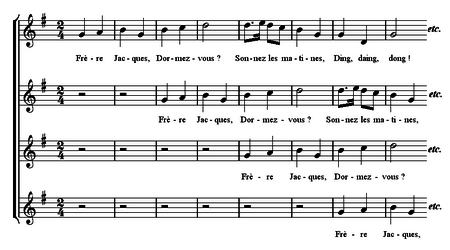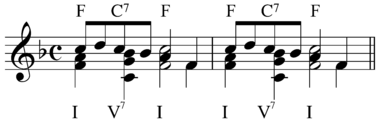Frère Jacques facts for kids
Quick facts for kids "Frère Jacques" |
|
|---|---|

Sheet music
|
|
| Nursery rhyme | |
| Language | French |
| English title | "Brother John" |
| Songwriter(s) | Unknown |
"Frère Jacques" ( in the nursery rhyme and in song more generally), also known in English as "Brother John", is a nursery rhyme of French origin. The rhyme is traditionally sung in a round.
The song is about a friar who has overslept and is urged to wake up and sound the bell for the matins, the midnight or very early morning prayers for which a monk would be expected to wake.
Contents
Lyrics
Frère Jacques, Frère Jacques,
Dormez-vous? Dormez-vous?
Sonnez les matines! Sonnez les matines!
Ding, dang, dong. Ding, dang, dong.
English translation
Brother Jacques, Brother Jacques,
Are you sleeping? Are you sleeping?
Ring/Sound [the bells for] matins! Ring [the bells for] matins!
Ding, dang, dong. Ding, dang, dong.
Traditional English lyrics
Are you sleeping? Are you sleeping?
Brother John, Brother John,
Morning bells are ringing! Morning bells are ringing!
Ding, dang, dong. Ding, dang, dong.
The song concerns a monk's duty to ring the bell for matines. Frère Jacques has apparently overslept, it is time to ring the bells for matins, and someone wakes him up with this song. The traditional English translation preserves the scansion, but alters the meaning such that Brother "John" is being awakened by the bells.
In English, the word friar is derived from the Old French word frere (Modern French frère; "brother" in English), as French was still widely used in official circles in England during the 13th century when the four great orders of Friars started. The French word frère in turn comes from the Latin word frater (which also means "brother").
The French name Jacques, meanwhile, would not ordinarily be translated to "John." "Jean" is the male French equivalent of the English "John." The name Jacques, instead, corresponds to the English names James or Jacob, all of which derive from the Latin Iacobus and the Greek Ἰακώβος (Septuagintal Greek Ἰακώβ), referring to the Biblical Patriarch Jacob and the apostles known in English as James.
Theories of origin
A possible connection between "Frère Jacques" and the 17th century lithotomist Frère Jacques Beaulieu (also known as Frère Jacques Baulot), as claimed by Irvine Loudon and many others, was explored by J. P. Ganem and C. C. Carson without finding any evidence for a connection.
Francesca Draughon and Raymond Knapp argue that "Frère Jacques" was originally a song to taunt Jews or Protestants or Martin Luther (see Frère Jacques in popular culture).
Martine David and A. Marie Delrieu suggest that "Frère Jacques" might have been created to mock the Dominican friars, known in France as the Jacobin order, for their sloth and comfortable lifestyles.
In a review of a book about Kozma Prutkov, Richard Gregg notes it has been claimed that "Frère Jacques" was derived from a Russian seminary song about a "Father Theofil".
Published record
First publication
AllMusic states that the earliest printed version of the melody is on a French manuscript circa 1780 (manuscript 300 in the manuscript collection of the Bibliothèque Nationale in Paris). The manuscript is titled "Recueil de Timbres de Vaudevilles", and the Bibliothèque Nationale estimates that it was printed between 1775 and 1785. The "Frère Jacques" melody is labelled "'Frère Blaise'" in this manuscript.
Sheet music collector James Fuld (1916–2008) states that the tune was first published in 1811, and that the words and music were published together in Paris in 1869. An earlier publication in 1825 included the words together with a description of the melody in solfège, but not in musical notation. The words and music appear together in Recreations de l'enfance: Recueil de Rondes avec Jeux et de Petites Chansons pour Faire Jouer, Danser et Chanter les Enfants avec un Accompagnement de Piano Très-Facile by Charles Lebouc, which was first published in 1860 by Rouart, Lerolle & Cie. in Paris. This book was very popular and it was republished several times, so many editions exist.
French musicologist Sylvie Bouissou has found some evidence that composer Jean-Philippe Rameau had written the music. A manuscript at the French National Library contains "Frère Jacques" among 86 canons, with Rameau listed as author.
In 1926, the tune was used in a patriotic anthem written by officers of the Whampoa Military Academy, "Revolution of the Citizens" (国民革命歌).
Comparison with Fra Jacopino
"Frère Jacques" bears resemblance to the piece Toccate d'intavolatura, No.14, Capriccio Fra Jacopino sopra L'Aria Di Ruggiero composed by Girolamo Frescobaldi, which was first published around 1615 - "Fra Jacopino" is one potential Italian translation for "Frère Jacques". Edward Kilenyi pointed out that "Fra Jacopino" shares the same "Frère Jacques"-like melody as "Chanson de Lambert", a French song dating from 1650, and a Hungarian folk tune.
The "Frère Jacques" tune is one of the most basic repeating canons along with the melody of "Three Blind Mice". It is also simple enough to have spread easily from place to place. For example, Barbara Mittler in a conference abstract points out that the melody of "Frère Jacques" is so thoroughly assimilated into Chinese culture that it might be widely regarded as a Chinese folksong in China called "Two tigers".
Influence
The song "Frère Jacques" often appears in popular culture.
In the fields of chemistry and cheminformatics, the circuit rank of a molecular graph (the number of rings in the smallest set of smallest rings) is sometimes referred to as the Frèrejacque number.
See also
 In Spanish: Frère Jacques para niños
In Spanish: Frère Jacques para niños



